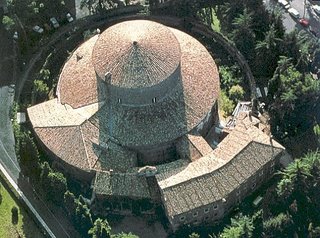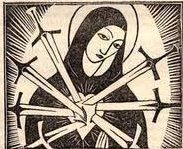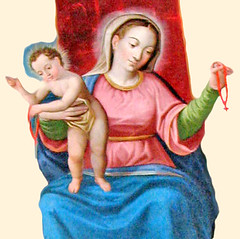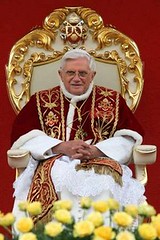Mater Dolorosa
 Station at Saint Stephen's on Mount Coelius
Station at Saint Stephen's on Mount Coelius Today's Stational church is popularly called 'Santo Stefano Rotondo', or St Stephen the Round, not on account of the saint's figure (!) but because this 5th-century church is a circular church modelled on the Rotunda of the Anastasis (Resurrection) in Jerusalem; indeed, it is the first circular church in Rome and has the same dimensions. Cambridge also has a beautiful round church which is aptly named the Church of the Holy Sepulchre. San Stefano was built to house the relics of St Stephen, the protomartyr which had been brought to Rome from Jerusalem but was later re-dedicated to St Stephen of Hungary. The church is built on the site of a large Mithraic sanctuary and it was given to the Jesuits in the 16th century but it is now in the care of the Hungaro-Germanic College.
The Cross which we focus on in Passiontide already brings the Resurrection in view. As Fr Herbert McCabe OP says: "Easter is how to look at the cross. It is how faith looks at the cross… seen in faith, the cross is the best picture of the resurrection" (God, Christ and Us, 89). Today's Station is that faith in brick and stone.
This church which enshrines a martyr and mirrors the Rotunda of the Anastasis symbolically illustrates today's Mass readings, where the prophet Jeremiah tells of God's power to rescue the just man from the "power of the wicked" who surround and beset him on every side. Jesus is that just man, the eminently Holy One who is delivered up to the hands of his enemies and ultimately to death itself. But the Father has foiled the Devil and by the power of the Holy Spirit has raised Jesus from the dead and so overthrown sin, evil and death. As such, this Stational church, as an icon of the Church of the Resurrection in Jerusalem, reminds us that the Victory belongs to the Lord and that, as Jeremiah said: "The Lord is with me, like a mighty champion: my persecutors will stumble, they will not triumph" (Jer 20:11).
The Gospel (Jn 10:31-42) also makes a reference to the Station: the Lord's persecutors attempt to stone Him, just as St Stephen was himself stoned to death as the first to shed blood for the Faith. However, the martyrs who follow in Christ's Passion will surely share in Christ's Resurrection for it is He, the "mighty champion" who has defeated death and who will thus save them from the powers of hell and so "perform my Father's works" (Jn 10:37); the work of salvation. This salvation is ours too if, with the help of God's grace, we will also carry our Cross, die with Christ and so rise with Him.
 On this day also, the Friday of Passiontide, the Church used to mark the Feast of the Seven Sorrows of Our Lady. Since the 17th century, the feast was kept on this day and it pre-dates the establishment of the feast in 1814 by Pope Pius VII for the universal Church on September 15. Although today's feast was suppressed after the reforms of Vatican II in order to sharpen our focus on the Lord's Passion, we do well as a matter of devotion to remember Our Lady's sorrows and to contemplate with her the Passion of her Son, and so share in her suffering. Interestingly the Vatican's Directory on Popular Piety and the Liturgy notes that "because of its doctrinal and pastoral importance, it is recommended that the memorial of 'Our Lady of Dolours' should be recalled" and explains that:
On this day also, the Friday of Passiontide, the Church used to mark the Feast of the Seven Sorrows of Our Lady. Since the 17th century, the feast was kept on this day and it pre-dates the establishment of the feast in 1814 by Pope Pius VII for the universal Church on September 15. Although today's feast was suppressed after the reforms of Vatican II in order to sharpen our focus on the Lord's Passion, we do well as a matter of devotion to remember Our Lady's sorrows and to contemplate with her the Passion of her Son, and so share in her suffering. Interestingly the Vatican's Directory on Popular Piety and the Liturgy notes that "because of its doctrinal and pastoral importance, it is recommended that the memorial of 'Our Lady of Dolours' should be recalled" and explains that:"As Christ was the 'man of sorrows' (Is 53, 3) through whom it pleased God to have 'reconciled all things through him and for him, everything in heaven and everything on earth, when he made peace by his death on the cross' (Col 1, 20), so too, Mary is 'the woman of sorrows' whom God associated with his Son as mother and participant in his Passion (socia passionis)."

The famous Sequence hymn, Stabat Mater Dolorosa, was written around the 13th century and assigned to this day in 1727. In addition to the current September 15 memorial it is still often sung as part of the Via Crucis devotion and has been set to sublime music by many composers, although my favourite has to be the setting by Pergolesi. One way I shall be contemplating Our Blessed Mother's sorrows is to listen to this setting and pray the words of that Sequence hymn. Perhaps you could do likewise? Alternatively, one may choose to pray the Chaplet of the Seven Sorrows of the Blessed Virgin Mary, a Rosary-like devotion of the Servite Order who promoted this devotion to the sorrowful Mother.
"O God, at whose Passion,
according to the prophecy of Simeon,
a sword of sorrow pierced the most sweet soul of
the glorious Virgin and Mother Mary;
Grant in thy mercy that we,
who call to mind with veneration her soul pierced with sorrow,
through the glorious merits and prayers of all the saints
faithfully standing by thy Cross,
may obtain the blessed result of thy Passion."
Amen.







4 Comments:
This comment has been removed by a blog administrator.
hi paul! it's nice to hear that you still relive your memories here in manila. hope to see you soon! God bless :)
Paul - slightly off topic, but as a future post would you consider sharing with us how your order prepares you to impart the Sacrament of Reconciliation?
I ask because it strikes me as a very difficult thing to be ready for, and I have wondered what kind of training could prepare someone for being on the other side of the screen....
That may have to be quite far in the future as I am still in novitiate formation but I will keep your request in mind!
Post a Comment
<< Home